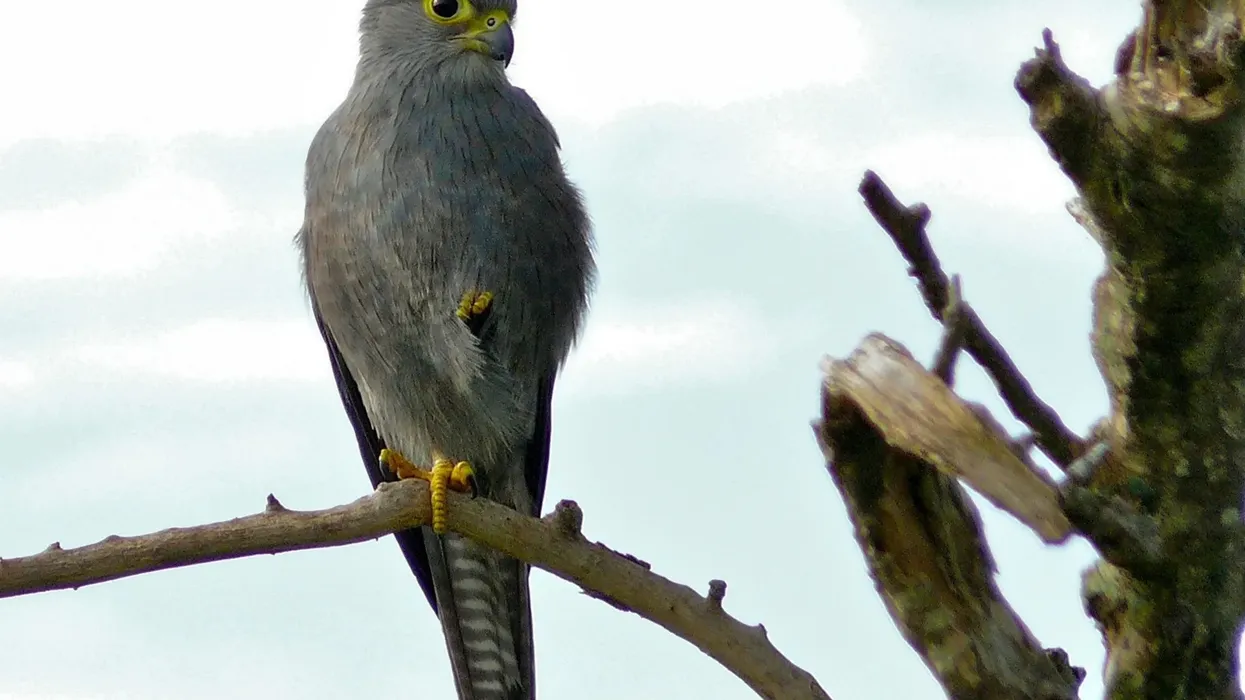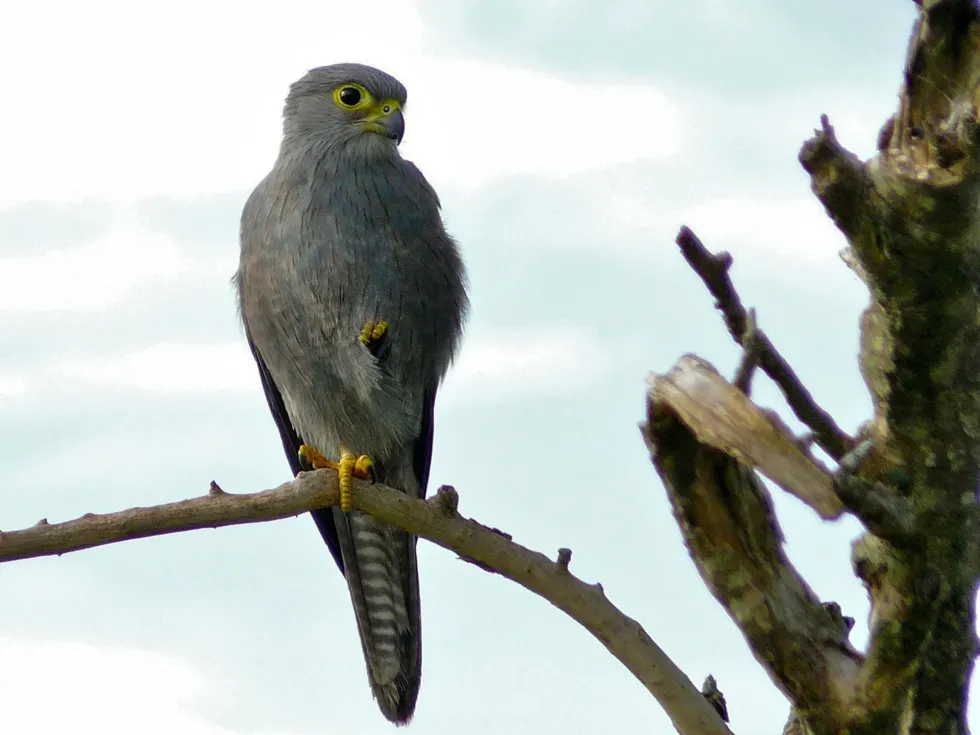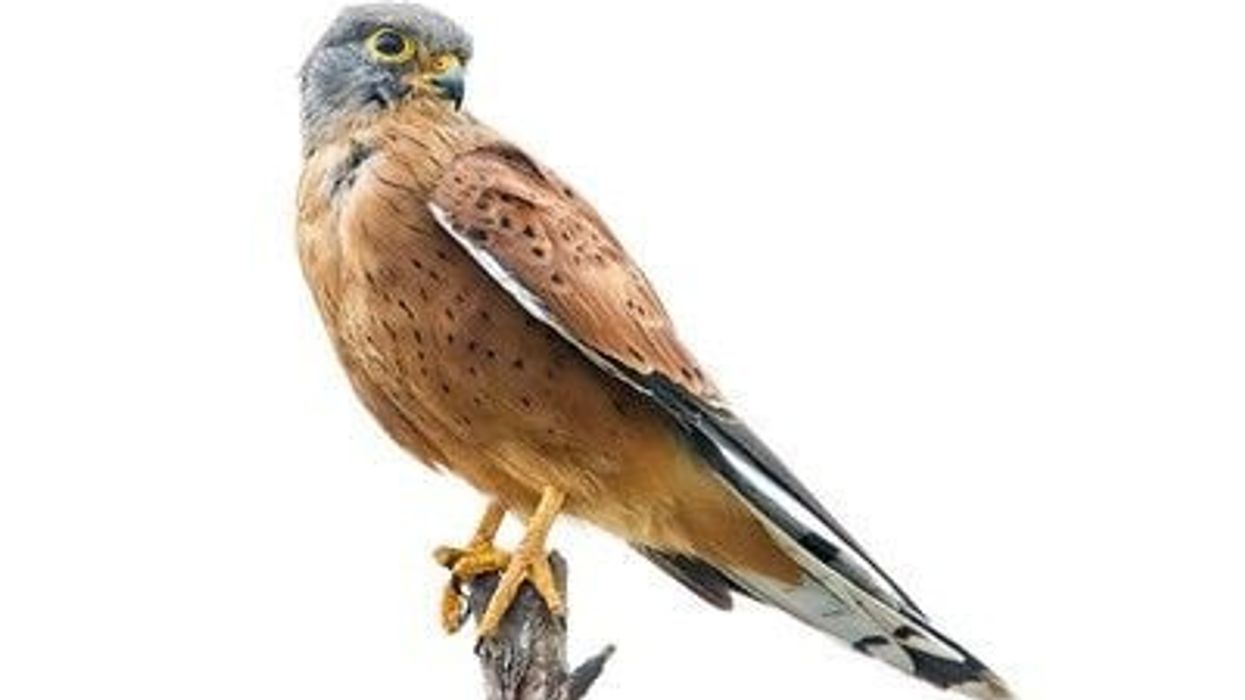The grey kestrel (Falco ardosiaceus) is a bird of prey native to Africa. It has an enormous plumage that is a sight to watch.
These birds are skilled raptors and twilight hunters. Another distinctive feature are bold yellow streaks highlighting their face.
This species is among the most famous African birds, often found in open fields, perching on telegraph poles, and hovering here and there on the ground to prey on small mammals. Like other falcons, they also showcase commendable agility while chasing their prey in the air. Kestrels form their nests in tree cavities.
Sometimes, they do not build their own nests but rather take over old or used nests of some other bird, most likely a woodpecker or a falcon. This skilled bird belongs to the family Falconidae and flies to the north during cold winters and navigates the south during hot summers.
Read on to know more about this African bird. For more relatable content, check out these kestrel bird facts and common buzzard facts for kids.
Grey Kestrel Interesting Facts
What type of animal is a grey kestrel?
The grey kestrel is amongst the most skilled predatory birds of the world that belongs to the family Falconidae. Their diet includes preying on insects, smaller mammals, and bird. The breeding season happens during the month of April. This bird migrates from the south to the north during seasonal change.
What class of animal does a grey kestrel belong to?
The grey kestrel belongs to the class of Aves.
How many grey kestrels are there in the world?
Grey kestrels are extensively present in the world. There is no exact number to suggest their current population.
Where does a grey kestrel live?
The grey kestrel lives in areas like open woodlands, clear forests, deserts, and cities of Africa, south of the Sahara. This bird has also been seen in eastern countries like Kenya, South Sudan, Tanzania, and Ethiopia.
What is a grey kestrel's habitat?
The grey kestrel is adaptable to harsh habitats, but the most favorable environments include clear and open woodland areas. They reside near the coast which has palm trees. Their habitat can be rural or urban, and they are often sighted perching on trees, telegraph poles, and hunting on the ground.
Who do grey kestrels live with?
Grey kestrels are typically solitary but while migrating south to north and vice versa during season change, they travel in flocks, containing around eight to 10 grey kestrels. However, they typically live a solitary life.
How long does a grey kestrel live?
These kestrels have a very short lifespan of four to five years.
How do they reproduce?
The breeding season of these falcons is focused in and around April. Before copulating, the male and female species of these birds are documented to perform aerobics in the air, spreading their wings beautifully in order to attract each other.
The breeding occurs in the nest which could be an old used nest of fellow birds. These kestrels sometimes frighten the other birds and steal their nests and monopolize them. The female lays her eggs in the nest in a clutch which includes around three or more eggs.
The incubation period of these birds is a month-long process. The young kestrels start fledging after about five weeks.
What is their conservation status?
These species of kestrels are not endangered as of current records, and so they are listed as Least Concern by the IUCN list of endangered species.
Grey Kestrel Fun Facts
What do grey kestrels look like?
Grey kestrels are tiny birds, with a flat head, a slate gray body, short wings and a wingspan of 22.8-28.3 in (58-72 cm). When at rest, the wings do not extend beyond the tail.
Typical of all other birds, the female is larger and heavier than the male. The adult kestrel has a uniform dark plumage and barred feathers.
The feet are yellow in color and the eyes also have a yellow taint around them. The juvenile grey kestrel has a brown body.
Unlike the adult kestrel, it has a greenish shade around its eyes and its tail and wings are more barred. The sooty falcon is one such bird of a similar species whose wings extend past the tail, and they have a more round head instead of flat and a lesser tint of yellow around the eyes.
How cute are they?
This grey kestrel (Falco ardosiaceus) is one of the most adorable birds of prey. The aerial chase they perform while capturing their prey and prior to breeding is a sight to watch.
How do they communicate?
The grey kestrel is mostly silent, however they might be a bit vocal during the breeding season. They produce shrill calls, whistles, and rattling sounds. Both the male and female species produce 'klee', 'chitter', and 'whine' sounds in order to share their anxiety and eagerness with each other.
How big is a grey kestrel?
Among all the falcon birds of the world, the grey kestrel (Falco ardosiaceus) is one of the most smallest and skilled birds of prey. This kestrel is 11-13 in (28-33 cm) in size with a wingspan of 22.8-28.3 in (58-72 cm). They are twice as big as European robins.
How fast can a grey kestrel fly?
A falcon is believed to be one of the fastest birds in the world. These kestrels can fly at a speed of 39 mph (62.8 kph).
How much does a grey kestrel weigh?
Theis species of kestrels weigh around 0.7 lb (300 g). Moreover, an adult female is slightly heavier than a male.
What are their male and female names of the species?
They do not have distinct names based on their sex. They are collectively called grey kestrels.
What would you call a baby grey kestrel?
No specific name has been given to a baby grey kestrel. It can most probably be called a chick or an eyas, just like the juveniles of hawks and falcons.
What do they eat?
Their diet includes a variety of insects, small mammals, and other birds. They might eat lizards, bats, robins, swifts, earthworms, grasshoppers, snails, beetles, and rats. They hunt during dusks and dawns and not in the daytime.
Are they dangerous?
They are dangerous only while hunting. It is advisable to maintain a safe distance from them.
Would they make a good pet?
Like any other falcon, these kestrels are not suitable to be kept as pets as these are wild birds with nature as their core domain.
Did you know...
A kestrel has a spiritual significance attached to it. A kestrel contemplates carefully and gathers all its energy for hunting. If a kestrel happens to enter your life, it suggests that you should be more mindful towards your dreams and goal. There is a lot of lessons about valor and wisdom to be learnt from this kestrel.
How do kestrels hunt their prey?
They have extremely sharp eyesight. They can spot their prey from 50 yds (45.7 m) away and see ultraviolet light which is invisible to the human eye. This bird of prey hunts by hovering from several feet above if the prey is on the ground, and through an aerial chase.
Do kestrels hunt other birds?
Yes, a kestral is a bird of prey. They are predatory and they kill other birds smaller than them.
Here at Kidadl, we have carefully created lots of interesting family-friendly animal facts for everyone to discover! Learn more about some other birds from our pileated woodpecker facts and American kestrel facts pages.
You can even occupy yourself at home by coloring in one of our free printable grey kestrel coloring pages.









